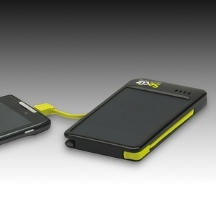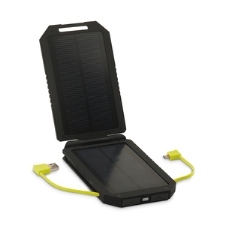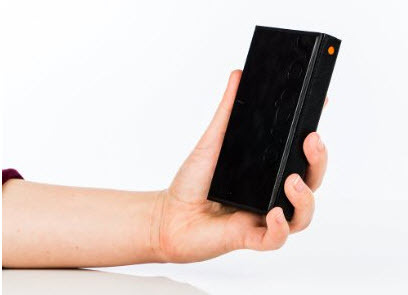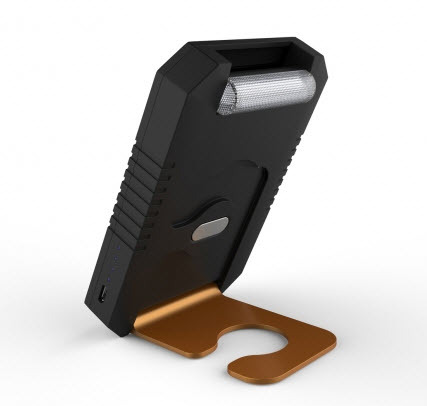As I've often mentioned, I inexplicably and somewhat irrationally love portable power banks. The best I can ever explain is the efficient elegance of their design, so many features built in to increase their portability - and usability. That gets ratcheted up a notch when you throw in solar devices. Portable power chargers are, of course, intended to be used when you're on the road with your portable devices when they (inevitably) run out of power, and you're away from a power source. But what happens when your charger itself runs out of power, and you're on a bus, walking between classes, or hiking in the middle of the woods?
Once upon a time I was enamored with solar chargers. Times have changed - they've improved, but so have the non-solar chargers, so the dynamic is more complex.
Reasonably small and light chargers now exist with 9,000 mAh - that can give you up to six charges of a mobile phone. You've got to be a scary power user if you can't get to a wall outlet before that runs out. And astonishingly tiny chargers (that fit in your shirt pocket now exist that can give you 2-3 phone charges, at 4000 mAh. Or you can now charge your devices from your car's cigarette lighter, lessening the need to find a wall outlet. Or you can charge from your laptop - or even from many portable speakers which provide that dual functionality. Furthermore, so many standard chargers now include built-in power cords - something I consider almost a requirement today. So, if a solar charger doesn't include those that basics, and is too bulky, its solar convenience might not be enough to make it viable, at least for everyday use. The point here is that, today, as they themselves have improved, solar power banks have a lot of impressive hurdles to overcome to make them worth considering. To be clear, such devices do exist - and most especially if you're a hiker or camper, particularly into the backwoods, they remain the gold standard, and today is their greatest value - but the task is finding them.
And so, we dive in to check out a few in this go-round.
- Secūr Sun Power Bank 4000
- Secūr Sun Power Bank 6000
- Solpro Helios Smart
- Xtorm Magma Charger and Flashlight A116
The Secūr Sun Power Bank 4000 gets things pretty close to right. It has respectable capacity, at 4,000 mAh - not huge, but plenty for almost three charges of a mobile phone. It's quite small, and impressively enough, at 4-3/4 ounces. Easy to stick in a pocket. And importantly, it includes two built-in cords - one for microUSB and one for a standard USB.
The microUSB cord has a basic 1.0 amp output for charging mobile phones, while the regular USB is 2.1 A, so it can be used to charge devices that require a more powerful draw, like a tablet (although, in practical usage, most tablets don't use a standard USB plug). However, the USB cord importantly can be used for plugging into a charger when you don't have to rely on the sun. One downside for Apple users - there's no built-in Lighting plug. To be clear, there is a USB port, so you can simply snap your Lightning plug in there, but something built in would have been more versatile. If you don't use Apple devices, though, but Android, Windows or anything else, this is not an issue. And having that standard USB cord instead is beneficial.
A couple other things I particularly like about the device. Solar panels charge by the surface area, which is why small solar power banks take a long time to fill to capacity. But the Secūr has a particularly efficient panel that covers a wide area. Charging time with the solar panel is rated a slow, but acceptable 14-18 hours under full sunlight. (An electric wall charge is, of course, much faster, 4 hours.)
Related to this, importantly, the panels are so efficient that they charge from any light source - not just the sun, but even a lamp (though it has to be direct and very close). And also, it charges from the sun even while indoors and just near a window in sunlight (not as efficiently as under a bright sun, but it still works). Most solar chargers I've come across don't do either of those, or at least well. As a result, if you just leave the Secūr out, near a window or right under a bright lamp, it could stay fully-charged. Also, it has a red light that glows very brightly when it's charging by solar power. That's no small thing. On many other solar chargers I've tested, the light can be dull and washed out. Four green lights that let you know your current capacity.
The device is extremely well-built. If it included a Lightning plug, I might almost call it an ideal solar charger. But as I said, if you have no need for Apple plugs, this is no issue. (And you can use a Lightning cord by plugging one in.) At the time of writing, it retailed for $60, but could be found online for $44.
Secūr's Sun Power Bank 6000 has much in common with its smaller sibling, the 4000, but there is one notable difference which makes this less valuable for everyday use, but significantly more valuable for another.
It too is extremely solidly made, has two built-in cables (one for microUSB and one standard USB), uses highly efficient solar panels, can charge from direct ambient light, has a clear bright light that glows when solar charging, and has a lithium battery, which here holds 6,000 mAh, enough for nearly four charges of a mobile phone. And like the Power Bank 4000, it can charge somewhat when simply near a window in sunlight, or directly under a bright lamp.
Unlike the 4000, this has two USB ports, the added one which is 2.1 amps which is very convenient, allowing you to plug in a cord for charging tablets since they require the larger 2.1A. There's also a great LCD screen which tells you precisely how much charge is left in the battery. (The holes are protectively covered with plugs that are attached to the device.) But what's most notable of all is that it opens like a clam shell.
This makes the device a bit larger than many chargers - it's thicker than many chargers (though not as much as those from the excellent myCharge) and taller at 6", so it won't fit as conveniently in a pocket...though it will fit. And when it opens up, it's significantly bigger. And heavier. However, it's still fairly light for its size and capacity, at 9.5 ounces.
But it's that opening up that makes the solar charger unique. As I said above, it's surface area that is most critical for the charging capacity of solar panels. By flipping open, the Solar Power Bank 6000 impressively doubles its already good-sized surface area, providing a great deal more solar charging power. Since it has a larger capacity than the 4000, it takes longer to do an electrical charge of itself, about six hours. Yet because it has a much larger solar panel surface, it can charge itself faster - in just 12-14 hours in full, bright sunlight, according to the company.
What all this does is make the Solar Power Bank 6000 terrific for day hikers and campers. When open, it has a convenient slot to hang from your gear. And it's light enough for its capacity not to be a burden. It's also far more compact than other solar options like those that use a standalone solar panel. Those are great for their huge surface area, but are much more unwieldy. For my own personal taste, there are other portable chargers (solar or otherwise) that I prefer for daily use - but if you do any amount of hiking or camping, this is one of the best I've seen. At the time of writing it retailed for $100, but could be found online for just $33.
The Solpro Helios is an intriguing solar charger that has a lot going for it, holding 5000 mAh, enough for about three charges of a smartphone. Though it also suffers in a few areas compared to some of its competition.
As I've mentioned, the most critical thing with solar chargers is the surface area of its solar panels. And though the Helios is a small device, it solves that problem by having its own built-in case with tri-fold panels that open to create expanded surface space. As a result, it only takes about 90 minutes for device to create enough power to charge a smartphone, or about five hours to create three charges, quite quick. (This is provided there is bright sunlight under optimal conditions.)
The Helios is about 5"x 3"wide, and .75" thick - though it will open to 11" wide. It weighs about 9.5 ounces - a bit on the heavy side for something this small if you're using it for backpacking, though not at all problematic. When the panels are open, there are two holes that allow you to rope a cord through so that you can hang the power bank to charge. A red light glows reasonably well-enough to see when charging in the sun.
A big plus for the device is that it comes with two USB ports, one that 1 Amp (which can charge standard smartphones), and another that's 2.1 Amp, that would allow for charging a tablet).
Being a "smart" power bank, there's an interesting feature when using the Helios. If you have a device connected to it for charging (for instance, a mobile phone), and you have the Helios plugged into a wall socket, the charge will pass through it to charge the phone directly. The advantage of this is that it won't use up any of the charge that's stored on the Helios.
At issue is that there are no built-in charging cables, something as I've mentioned I consider should be standard, and you have to supply your own. Also, while there are tiny plugs to protect the ports, they are unconnected and can easily be lost. The package comes with a spare set, though they still can get loose easily. To be fair, I'm not sure if the plugs are all that necessary. Finally, though those two "hanging holes" are good to have, they aren't nearly as convenient as the big slot on the Secūr 6000.
The Solpro Helios Smart is an extremely well-made, sturdy device. It's very well designed, most notably with its tri-fold panels, and pretty fast-charging. However, I think the advantages of the Secur 6000 are significant, most notably the built-in cords - unless you prefer the sleek design of the Helios and its ability to have the pass-through charge. At the time of writing, it retails for $100, but could be found online for $77.
Xtorm is a very good Dutch company that makes a range of devices, notably chargers, and in particular has long specialized in solar chargers. I've reviewed quite a few of them here in the past.
One of the things I like so much about portable power banks is how well-designed they are, putting impressive functionality into small and light devices. The Xtorm Magma is a perfect example. On the surface, the Magma is a fairly standard solar power bank, exceeded by a lot of the competition. However, it uniquely adds great functionality by have a flashlight built-in - which itself can double as a reading light.
The charger holds 3000 mAh, not huge but enough to charge a smartphone almost two times. However, there's only one USB port, which is for a 1 amp device, so you couldn't use this to charge a tablet. And with a small surface area of solar panels, it should take 7-9 hours to fully charge the Magma. However, it's the 4 LED bulbs on a swiveling panel that set the Magma apart.
Campers know that multi-functionality is very important when backpacking. Packing space is limited, and weight is a premium. So, a power bank that can double as a flashlight - and reading lamp - is of high value. Tap its power button twice, and the lights emit fairly bright light. Twist them down, and you have an effective reading light. (And since LED lights don't use much power, you could have them shining for up to 12 hours on a full charge.) There's a very sturdy aluminum hook which you can hang on a backpack or anywhere to aid in charging the device - and then you can twist it to become a stand when used for reading, and adjust the angle. Oddly, my only quibble is that I wish the hook/stand wasn't as solidly-made as it is, since that adds a bit of weight to the device. The Magma isn't as light as I'd wish, but it's absolutely fine at just 5 ounces, and fits easily in a pocket.
Xtorm products aren't always easily found in the United States, though they can all be purchased on the company's website, though international shipping is added. However, the company has been expanding its outlets, and many of their devices are now available on Amazon and elsewhere, including the Magma A116. At the time of writing, it retails for $60.
*
"The Writers Workbench" appears monthly on the website for the Writers Guild of America. To see this entire column, with complete product graphics and additional "TWW Notes," please click here
*
To read more from Robert J. Elisberg about this or many other matters both large and tidbit small, see Elisberg Industries.





